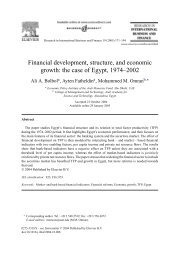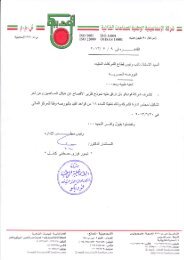Does the inflation rate affect the performance of the stock market ...
Does the inflation rate affect the performance of the stock market ...
Does the inflation rate affect the performance of the stock market ...
Create successful ePaper yourself
Turn your PDF publications into a flip-book with our unique Google optimized e-Paper software.
264<br />
( )<br />
M. Omran, J. Pointon Emerging Markets Reiew 2 2001 263279<br />
<strong>stock</strong> <strong>market</strong>s. This paper focuses upon Egypt as an important example <strong>of</strong> a<br />
successful economic experiment within <strong>the</strong> Middle East region. Since <strong>inflation</strong> has<br />
tended to have a negative impact on <strong>stock</strong> <strong>market</strong> <strong>performance</strong>, such economic<br />
policies have benefited <strong>the</strong> <strong>stock</strong> <strong>market</strong>s. Many academic investigations into <strong>the</strong><br />
impact <strong>of</strong> <strong>inflation</strong> have concent<strong>rate</strong>d upon <strong>the</strong> effects on returns to investors. It<br />
should be mentioned that <strong>the</strong> <strong>market</strong> index in Egypt was established in late 1993.<br />
This means that to analyze statistically <strong>the</strong> impact on returns is not sensible for<br />
such a short period <strong>of</strong> time. However, o<strong>the</strong>r aspects <strong>of</strong> <strong>stock</strong> <strong>market</strong> <strong>performance</strong>,<br />
such as <strong>market</strong> activity and liquidity have been neglected. Yet, it is particularly<br />
important for policy-makers to look at <strong>market</strong> activity and liquidity, since <strong>the</strong>se<br />
give indicators <strong>of</strong> <strong>the</strong> <strong>market</strong>’s attraction as a channel for investment and a source<br />
<strong>of</strong> finance for businesses<br />
When Egypt started its economic reform program by late 1990, <strong>the</strong> <strong>inflation</strong> <strong>rate</strong><br />
had been targeted to be under control in order to create an attractive environment<br />
for investment. With regard to this program, Egypt has witnessed major and radical<br />
changes in its economic climate. The aim <strong>of</strong> this program was to increase <strong>the</strong><br />
growth <strong>rate</strong> <strong>of</strong> <strong>the</strong> economy. This objective is not likely to be achieved without<br />
increasing <strong>the</strong> level <strong>of</strong> investment. In turn, this investment can be obtained through<br />
creating a strong <strong>stock</strong> exchange <strong>market</strong> that is capable <strong>of</strong> attracting local and<br />
foreign investment. In fact, it was vital for <strong>the</strong> Egyptian economy to depress <strong>the</strong><br />
high <strong>inflation</strong> <strong>rate</strong> in <strong>the</strong> first stage <strong>of</strong> <strong>the</strong> economic reform program period. In<br />
turn, <strong>the</strong> government chose to restrict <strong>the</strong> demand for goods and services by<br />
putting <strong>the</strong> <strong>inflation</strong> <strong>rate</strong> under control in <strong>the</strong> short-term, since <strong>the</strong> o<strong>the</strong>r alternative,<br />
which represented an increase in <strong>the</strong> supply <strong>of</strong> goods and services, usually,<br />
needs a long time. In light <strong>of</strong> this, <strong>the</strong> Egyptian government introduced treasury<br />
bills in 1991 followed by treasury bonds Ž 510 years.<br />
in 1995. In <strong>the</strong> meantime, <strong>the</strong><br />
<strong>rate</strong>s <strong>of</strong> interest liberalized and real interest <strong>rate</strong>s became positive, and in turn, all<br />
<strong>the</strong>se procedures helped in absorbing <strong>the</strong> level <strong>of</strong> liquidity. As a conclusion, <strong>the</strong><br />
liquidity growth declined from over 27% in 19901991 to only 8.7% in 19971998<br />
Ž Central Bank <strong>of</strong> Egypt 1998 ..<br />
On <strong>the</strong> o<strong>the</strong>r hand, <strong>the</strong> decline in <strong>the</strong> budget deficit, combined with a relatively<br />
stable exchange <strong>rate</strong>, assisted in decreasing <strong>the</strong> <strong>rate</strong> <strong>of</strong> <strong>inflation</strong>.<br />
This paper will focus upon examining <strong>the</strong> impact <strong>of</strong> <strong>the</strong> <strong>inflation</strong> <strong>rate</strong> on <strong>the</strong><br />
<strong>stock</strong> <strong>market</strong> activity and liquidity in Egypt. In turn, we will consider previous<br />
empirical studies on <strong>inflation</strong> and <strong>stock</strong> prices and returns, <strong>the</strong> background<br />
literature, <strong>the</strong> hypo<strong>the</strong>ses, and <strong>the</strong> data set and <strong>the</strong>n move on to set out <strong>the</strong><br />
methodology based on co-integration analysis. The results <strong>of</strong> <strong>the</strong> analysis will <strong>the</strong>n<br />
follow, before <strong>the</strong> summary and conclusions.<br />
2. Literature review<br />
The impact <strong>of</strong> <strong>inflation</strong> on <strong>the</strong> Egyptian <strong>stock</strong> <strong>market</strong> does not appear to have<br />
been <strong>the</strong> subject <strong>of</strong> prior study. However, Omran and Pointon Ž 2000.<br />
examined <strong>the</strong><br />
cost <strong>of</strong> capital in Egypt based on a sample <strong>of</strong> 109 companies, although <strong>the</strong>ir








